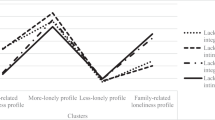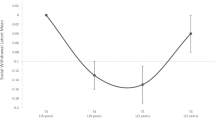Abstract
The overarching goal of this study was to examine the associations between three social withdrawal subtypes (shyness, unsociability, avoidance), peer isolation, peer difficulties (victimization, rejection, exclusion, low acceptance), and loneliness in India during early adolescence. Participants were 194 adolescents in Surat, India (M age = 13.35 years). Peer nominations of peer relations and socioemotional behaviors were gathered, along with self-reports of reasons for being alone and loneliness. Preliminary evidence of validity for the self-report measure of withdrawal subtypes and isolation was found, and factor analyses indicated that shyness, unsociability, and avoidance represent related, but distinct forms of withdrawal that are distinct from isolation. Shyness and avoidance were uniquely associated with loneliness and exclusion, but unsociability was not. The association between avoidance and loneliness was mediated by exclusion. Findings suggest that social withdrawal may be best conceptualized as a multifaceted construct during childhood and adolescence, in Western and non-Western societies.

Similar content being viewed by others
References
Aiken, L. S., & West, S. G. (1991). Multiple regression: Testing and interpreting interactions. Newbury Park: Sage.
American Psychiatric Association. (1994). Diagnostic and statistical manual of mental disorders (4th ed.). Washington, DC: Author.
Asendorpf, J. (1990). Beyond social withdrawal: shyness, unsociability, and peer avoidance. Human Development, 33, 250–259.
Asendorpf, J. (1993). Abnormal shyness in children. Journal of Child Psychology & Psychiatry, 34, 1069–1081.
Asher, S., & Paquette, J. (2003). Loneliness and peer relations in childhood. Current Directions in Psychological Science, 12, 75–78.
Asher, S. R., Hymel, S., & Renshaw, P. D. (1984). Loneliness in children. Child Development, 55, 1456–1464.
Baron, R., & Kenny, D. (1986). The moderator–mediator variable distinction in social psychological research: conceptual, strategies, and statistical considerations. Journal of Personality and Social Psychology, 51, 1173–1182.
Boivin, M., Hymel, S., & Bukowski, W. (1995). The roles of social withdrawal, peer rejection, and victimization by peers in predicting loneliness and depressed mood in childhood. Development and Psychopathology, 7, 765–785.
Bowker, J., Rubin, K. H., & Coplan, R. J. (2010). Social withdrawal in adolescence. In R. J. R. Levesque (Ed.), Encyclopedia of adolescence. New York: Springer (in press).
Cattell, R. B. (1966). The scree test for the number of factors. Multivariate Behavioral Research, 1, 245–276.
Chen, X., He, Y., De Oliveira, A. M., Lo Coco, A., Zappulla, C., Kaspar, V., et al. (2004). Loneliness and social adaptation in Brazilian, Canadian, Chinese and Italian children. Child Psychology and Psychiatry and Allied Disciplines, 45, 1373–1384.
Chen, X., Chung, J., & Hsiao, C. (2008). Peer interactions, relationships and groups from a cross-cultural perspective. In K. H. Rubin, W. Bukowski, & B. Laursen (Eds.), Handbook of peer interactions, relationships, and groups. New York: Guilford.
Coie, J., Dodge, K., & Kupersmidt, J. (1990). Peer group behavior and social status. In S. Asher & J. Coie (Eds.), Peer rejection in childhood (pp. 17–59). New York: Cambridge University Press.
Coplan, R. J., & Armer, M. (2007). A “multitude” of solitude: a closer look social withdrawal and nonsocial play in early childhood. Child Development Perspectives, 1, 26–32.
Coplan, R. J., & Weeks, M. (2010). Unsociability in middle childhood: Conceptualization, assessment, and associations with socio-emotional functioning. Merrill-Palmer Quarterly, 56, 105–130.
Coplan, R., Prakash, K., O’Neil, K., & Armer, M. (2004). Do you “want” to play? Distinguishing between conflicted shyness and social disinterest in early childhood. Developmental Psychology, 40, 244–258.
Coplan, R. J., Wilson, J., Frohlick, S. L., & Zelenski, J. (2006). A person-oriented analysis of behavioral inhibition and behavioral activation in childhood. Personality and Individual Differences, 917–927.
Crozier, W. R. (1995). Shyness and self-esteem in middle childhood. British Journal of Educational Psychology, 65, 85–95.
Eisenberg, N., Shepard, S., Fabes, R. A., Murphy, B., & Guthrie, I. (1998). Shyness and children’s emotionality, regulation, and coping: contemporaneous, longitudinal, and across-context relations. Child Development, 68, 767–790.
Eisenberg, N., Pidada, S., & Liew, J. (2001). The relations of regulation and negative emotionality to Indonesian children’s social functioning. Child Development, 72, 1747–1763.
Gavinski-Molina, M., Coplan, R., & Younger, A. (2003). A closer look at children’s knowledge about social isolation. Research in Childhood Education, 18, 93–104.
Gazelle, H., & Ladd, G. (2003). Anxious solitude and peer exclusion: a diathesis-stress model of internalizing trajectories in childhood. Child Development, 74, 257–278.
Gazelle, H., & Rudolph, K. (2004). Moving toward and away from the world: social approach and avoidance trajectories in anxious solitary youth. Child Development, 75, 829–849.
Graham, S., & Juvonen, J. (2002). Ethnicity, peer harassment, and adjustment in middle school: an exploratory study. Journal of Early Adolescence, 22, 173–199.
Kapadia, S., & Miller, J. (2005). Parent–adolescent relationships in the context of interpersonal disagreements. Psychology & Developing Societies, 17, 33–50.
Kazdin, A. E. (1986). Comparative outcome studies of psychotherapy: methodological issue and strategies. Journal of Consulting and Clinical Psychology, 54, 95–105.
Khatri, P., & Kupersmidt, J. B. (2003). Aggression, peer victimization, and social relationships among rural Indian youth. International Journal of Behavioral Development, 27, 87–95.
Kim, J., Rapee, R., Oh, K., & Moon, H. (2008). Retrospective report of social withdrawal during adolescence and current maladjustment in young adulthood: cross-cultural comparisons between Australian and South Korean students. Journal of Adolescence, 31, 543–563.
Kress, V. E., Eriksen, K., Rayle, A., & Ford, S. (2005). The DSM-IV-TR and culture: considerations for counselors. Journal of Counseling & Development, 83, 97–104.
Larson, R. W. (1997). The emergence of solitude as a constructive domain of experience in early adolescence. Child Development, 68, 80–93.
MacKinnon, D., Lockwood, C., Hoffman, J. M., West, S., & Sheets, V. (2002). A comparison of methods to test significance of the mediated effect. Psychological Methods, 7, 83–104.
Oh, W., Rubin, K., Bowker, J., Booth-LaForce, C., Rose-Krasnor, L., & Laursen, B. (2008). Trajectories of social withdrawal middle childhood to early adolescence. Journal of Abnormal Child Psychology, 36, 553–566.
Prakash, K., & Coplan, R. J. (2007). Socio-emotional characteristics and school adjustment of socially-withdrawn children in India. International Journal of Behavioural Development, 31, 123–132.
Preacher, K. J., & Hayes, A. F. (2004). SPSS and SAS procedures for estimating indirect effects in simple mediation models. Behavior Research Methods, Instruments & Computers, 36, 717–731.
Preacher, K. J., & MacCallum, R. C. (2003). Repairing Tom Swift’s electric factor analysis machine. Understanding Statistics, 2, 13–43.
Rubin, K. H. (1982). Nonsocial play in preschoolers: necessarily evil? Child Development, 53, 651–657.
Rubin, K. H., Chen, X., McDougall, P., Bowker, A., & McKinnon, J. (1995). The Waterloo Longitudinal Project: predicting adolescent internalizing and externalizing problems from early and mid-childhood. Development and Psychopathology, 7, 751–764.
Rubin, K., Bukowski, W., & Parker, J. (2006). Peer interactions, relationships, and groups. In N. Eisenberg, W. Damon, & R. Lerner (Eds.), Handbook of child psychology: Volume 3, social, emotional, and personality development (pp. 571–645). Hoboken: Wiley.
Rubin, K. H., Coplan, R. J., & Bowker, J. (2009). Social withdrawal in childhood. Annual Review of Psychology, 60, 11.1–11.31.
Sinha, J., Sinha, T., Verma, J., & Sinha, R. (2001). Collectivism coexisting with individualism: an Indian scenario. Asian Journal of Social Psychology, 4, 133–145.
Sinha, J., Vohra, N., Singhal, S., Sinha, R., & Ushashree, S. (2002). Normative predictions of collectivist–individualist intentions and behavior of Indians. International Journal of Psychology, 37, 309–319.
Spangler, T. L., & Gazelle, H. (2009). Anxious solitude, unsociability, and peer exclusion in middle childhood: a multi-trait multi-method matrix. Social Development, 18, 833–856.
Verma, S., & Saraswathi, T. S. (2002). Adolescence in India: Street urchins or Silicon Valley millionaires? In B. Brown, R. Larson, & T. S. Saraswathi (Eds.), The world’s youth: Adolescence in eight regions of the globe (pp. 105–140). Cambridge: Cambridge University Press.
Wojslawowicz Bowker, J. C., Rubin, K. H., Burgess, K. B., Rose-Krasnor, L., & Booth-LaForce, C. L. (2006). Behavioral characteristics associated with stable and fluid best friendship patterns in middle childhood. Merrill-Palmer Quarterly, 52, 671–693.
Acknowledgements
The authors gratefully acknowledge Craig Colder, Rob Coplan, Larry Nelson, and Len Simms for their helpful comments on an earlier version of this manuscript, and the students, principals, and teachers who participated in this study.
Author information
Authors and Affiliations
Corresponding author
Appendix
Appendix
Child Social Preference Scale-Revised
Peer isolation items
I want to play with others but often they don’t want to play with me.
I wish I could spend more time with other kids, but they don’t let me.
I’d like to hang out with other kids, but I’m often excluded.
Sometimes kids don’t want me to hang out with them.
Unsociability items
I don’t really mind spending time alone.
I like spending time alone more than I like spending time with other kids.
I don’t really like being with other kids and prefer being alone.
I don’t have a strong need to be with other kids.
Avoidance items
I am the happiest when I am playing with other kids. (reversed)
When given the choice, I prefer to play with other kids than to play alone. (reversed)
When given the choice, I always choose to play by myself because I don’t like playing with others.
Shyness items
Although I desire to be with other kids, I feel nervous about interacting with them.
Sometimes I turn down chances to hang out with other kids because I feel too shy.
I stand near where other kids are playing, without joining in.
I’d like to play with other kids, but I’m sometimes nervous to.
Rights and permissions
About this article
Cite this article
Bowker, J.C., Raja, R. Social Withdrawal Subtypes during Early Adolescence in India. J Abnorm Child Psychol 39, 201–212 (2011). https://doi.org/10.1007/s10802-010-9461-7
Published:
Issue Date:
DOI: https://doi.org/10.1007/s10802-010-9461-7




